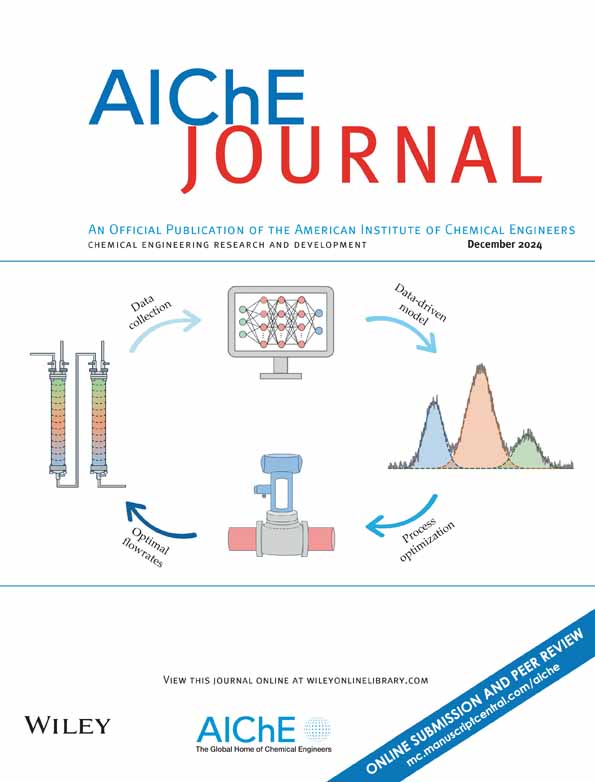Construction of MoOx-C interface with two active sites by plasma for low-temperature reverse water-gas shift reaction
IF 3.5
3区 工程技术
Q2 ENGINEERING, CHEMICAL
引用次数: 0
Abstract
The design and synthesis of robust catalysts is the key to improving CO2 conversion in the reverse-water gas shift (RWGS). In this article, the MoOx-C catalyst supported on AlOOH (xMoOx-C@AOH) is designed and synthesized by dielectric barrier discharge (DBD) plasma. The Mo-C bonds of the MoOx-C interface regulate the electronic structure of MoOx and promote the formation of oxygen vacancies. The catalyst evaluation and reaction kinetics of the xMoOx-C@AOH demonstrate excellent performance (CO2 conversion 15.8% at 450°C) and superior selectivity toward CO (100%), without obvious deactivation within 100 h. The high activity of xMoOx-C@AOH is related to two active sites: Mo sites of Mo-C are favorable for H2 adsorption/dissociation; oxygen vacancies of MoOx promote the adsorption/dissociation of CO2. Two RWGS mechanisms are confirmed by DRIFTs: formate and direct CO2 dissociation. This strategy of constructing the interface by DBD provides valuable insights to prepare high-performance catalysts for RWGS.等离子体构建双活性位MoOx-C界面用于低温逆水气移反应
高效催化剂的设计和合成是提高反水气变换(RWGS)过程中CO2转化率的关键。本文采用介质阻挡放电(DBD)等离子体设计合成了AlOOH (xMoOx-C@AOH)负载的MoOx-C催化剂。MoOx- c界面的Mo-C键调节MoOx的电子结构,促进氧空位的形成。催化剂评价和反应动力学表明,xMoOx-C@AOH催化剂性能优异(450℃时CO2转化率15.8%),对CO的选择性高(100%),在100 h内无明显失活。xMoOx-C@AOH的高活性与两个活性位点有关:Mo- c的Mo位点有利于H2的吸附/解离;MoOx的氧空位促进CO2的吸附/解离。DRIFTs证实了两种RWGS机制:甲酸和直接CO2解离。这种通过DBD构建界面的策略为制备高性能RWGS催化剂提供了有价值的见解。
本文章由计算机程序翻译,如有差异,请以英文原文为准。
求助全文
约1分钟内获得全文
求助全文
来源期刊

AIChE Journal
工程技术-工程:化工
CiteScore
7.10
自引率
10.80%
发文量
411
审稿时长
3.6 months
期刊介绍:
The AIChE Journal is the premier research monthly in chemical engineering and related fields. This peer-reviewed and broad-based journal reports on the most important and latest technological advances in core areas of chemical engineering as well as in other relevant engineering disciplines. To keep abreast with the progressive outlook of the profession, the Journal has been expanding the scope of its editorial contents to include such fast developing areas as biotechnology, electrochemical engineering, and environmental engineering.
The AIChE Journal is indeed the global communications vehicle for the world-renowned researchers to exchange top-notch research findings with one another. Subscribing to the AIChE Journal is like having immediate access to nine topical journals in the field.
Articles are categorized according to the following topical areas:
Biomolecular Engineering, Bioengineering, Biochemicals, Biofuels, and Food
Inorganic Materials: Synthesis and Processing
Particle Technology and Fluidization
Process Systems Engineering
Reaction Engineering, Kinetics and Catalysis
Separations: Materials, Devices and Processes
Soft Materials: Synthesis, Processing and Products
Thermodynamics and Molecular-Scale Phenomena
Transport Phenomena and Fluid Mechanics.
 求助内容:
求助内容: 应助结果提醒方式:
应助结果提醒方式:


